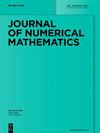应用于奇摄动反应扩散问题稀疏网格有限元法的平衡范数误差估计
IF 4
2区 数学
Q1 MATHEMATICS
引用次数: 6
摘要
摘要考虑二维单位方阵上的奇摄动线性反应扩散问题。标准的有限元分析使用能量范数,但对于这类问题,该范数太弱,无法充分捕捉解决方案中出现的边界层的行为。为了解决这一缺陷,一些研究人员最近考虑了一种更强的所谓“平衡”规范。本文利用Shishkin网格上的两尺度和多尺度稀疏网格有限元方法来求解反应扩散问题,并证明了它们的计算解在平衡范数下的收敛性。本文章由计算机程序翻译,如有差异,请以英文原文为准。
Balanced-norm error estimates for sparse grid finite element methods applied to singularly perturbed reaction–diffusion problems
Abstract We consider a singularly perturbed linear reaction–diffusion problem posed on the unit square in two dimensions. Standard finite element analyses use an energy norm, but for problems of this type, this norm is too weak to capture adequately the behaviour of the boundary layers that appear in the solution. To address this deficiency, a stronger so-called ‘balanced’ norm has been considered recently by several researchers. In this paper we shall use two-scale and multiscale sparse grid finite element methods on a Shishkin mesh to solve the reaction–diffusion problem, and prove convergence of their computed solutions in the balanced norm.
求助全文
通过发布文献求助,成功后即可免费获取论文全文。
去求助
来源期刊
CiteScore
5.90
自引率
3.30%
发文量
17
审稿时长
>12 weeks
期刊介绍:
The Journal of Numerical Mathematics (formerly East-West Journal of Numerical Mathematics) contains high-quality papers featuring contemporary research in all areas of Numerical Mathematics. This includes the development, analysis, and implementation of new and innovative methods in Numerical Linear Algebra, Numerical Analysis, Optimal Control/Optimization, and Scientific Computing. The journal will also publish applications-oriented papers with significant mathematical content in computational fluid dynamics and other areas of computational engineering, finance, and life sciences.

 求助内容:
求助内容: 应助结果提醒方式:
应助结果提醒方式:


